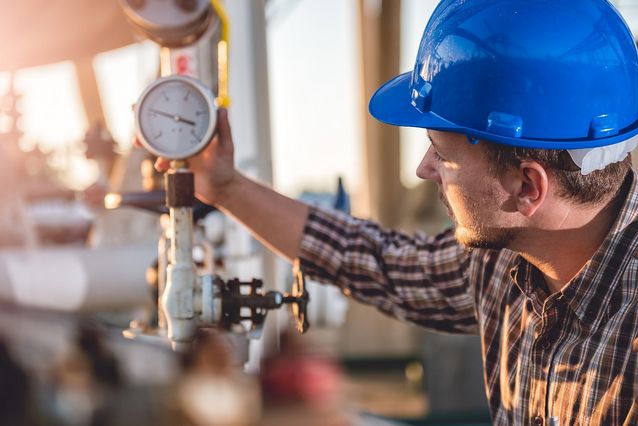
Methane – CH₄, the main component of natural gas – might be the key to the success of the hydrogen economy. There are enormous challenges in hydrogen transportation and storage that can be solved by the methanation of renewable hydrogen using captured carbon dioxide or carbon monoxide. In the best case, we can create new carbon sinks and convert many industries to carbon negative.
Hydrogen, H2, is a tricky molecule. Although we have recently taken large strides in developing emission-free hydrogen production, there are many unmet challenges in hydrogen storage and transportation.
Hydrogen is the smallest and lightest of all the elements – and that's why it has some unique characteristics. Hydrogen can enter and diffuse through steel even at room temperature. [1] It can also penetrate the crystal structure of steel, which cause the steel's rigidity to become brittle and weaken. [2] This failure, combined with a requirement to withstand high pressures, makes many ordinary steel structures unfit for storing hydrogen. We can build pipelines to transport hydrogen transportation and steel structures to store it, but avoiding unintended leaks remains challenging.
Compared to liquid hydrocarbon fuels, hydrogen's lower volumetric energy density creates significant challenges. Three times as many vessels would be needed to ship the same energy as liquefied natural gas (LNG). The energy losses from cooling and liquefying the hydrogen would increase this to four times as many. While technically feasible, it is impossible to do that economically. [3] The costs are too high.
We need more solutions for the transport and storage of hydrogen.

Ammonia is risky
I was recently in Japan to discuss the opportunities of hydrogen. Japan is doing a fantastic job developing hydrogen technology and promoting its use. Among others, they plan to import hydrogen from Australia by sea. [4]
To solve the problems with storage and transportation, the Japanese have carefully studied the opportunities of ammonia, NH₃. In 1909, Fritz Haber and Carl Bosch developed a process to react hydrogen and atmospheric nitrogen under pressure to make ammonia. The Haber–Bosch process remains responsible for nearly all the world's ammonia and derivatives like urea and ammonium nitrate. [5]
Carrying ammonia would be more economical than transporting hydrogen. Ammonia has a higher energy density,12.7 megajoules per litre (MJ/L), than even liquid hydrogen, at 8.5 MJ/L. Liquid hydrogen must be stored at cryogenic conditions of −253 °C, whereas ammonia can be stored at a much less energy-intensive −33 °C. [6] There is also existing global infrastructure for and vast knowledge of ammonia transport.
However, ammonia is poisonous: exposure to large amounts of ammonia can cause death from a swollen throat or from chemical burns to the lungs. [7] Ammonia can be transported at sea by dedicated vessels and trained crew. However, in most cases, you cannot transport and store ammonia close to densely populated areas, limiting the possibility of expanding its use.
In brief, ammonia can provide hydrogen transport on water but not on land.

Methane is safer and easier to handle
Methane, CH₄, is the primary component of natural gas, which has been transported and used for decades. In 2020, the world produced over 4000 billion cubic metres (bcm) of natural gas. [8] The industry and heating of several countries rely on the natural gas supply. Natural gas now accounts for about a quarter of global electricity generation. [9] Now, the world uses much more natural gas than coal: according to the International Energy Agency (IEA), in 2019, the world's total natural gas consumption was 68.4 EJ, compared to 39.8 EJ of coal and 169.0 EJ of oil. [10]
The world has built a vast infrastructure for methane that we could use in the era of renewable hydrogen. The benefit of the infrastructure is extensive — for example, the German natural gas pipelines are valued at more than €400 bn.
Methane is relatively safe compared to hydrogen and ammonia and easier to store. The energy densities of methane and LNG are 50–55.5 MJ/kg and 25 MJ/L, respectively. LNG is natural gas cooled down to −162 °C. [11]
Some additional benefits of methane are its reliability and flexibility. Even though natural gas is a marginal fuel in the European electricity system, it supplies a large part of the flexible electricity supply. [12] Large gas turbines can be turned on and off quickly, often with 15 minutes' notice, and gas engines are even quicker.
We can turn hydrogen into methane and back
Burning natural gas creates greenhouse gas (GHG) emissions, and we must reach a zero-emission world as soon as possible. However, methane is more than just the main component of natural gas: we can sustainably produce it ourselves.
Renewable hydrogen can be turned into methane by methanation, which converts carbon monoxide and carbon dioxide (COx) to methane through hydrogenation. Sabatier and Senderens first discovered the methanation of COx in 1902. The original processes were somewhat inefficient and costly. Still, new technologies are entering the field, tested by companies such as Tokyo Gas. [13]
We can also use carbon from other sources, like the forest industry. Their CO₂ emissions are from wood, biological material that would rot in the forest. Burning methane from bio-based CO2 sources does not add GHG emissions to the atmosphere.
The best outcome is a proper last-mile solution for hydrogen: pyrolysis. In other words, synthetic methane can be decomposed into hydrogen and solid carbon close to the end customer. Solid carbon can be used in industrial applications that create a carbon sink. We already have a pilot running with economically viable technology for that last-mile solution. [14] On a larger scale, this would turn the industry carbon negative.

Biogas supports sustainability
A new methane economy can also use biogas effectively. Biogas, a mixture mainly of methane and carbon dioxide, is a well-known renewable gas from anaerobic digestion. As methane is the main component of both fossil natural gas and biogas, they can easily be exchanged. Upgrading biogas to biomethane by removing CO2 gives a product similar to natural gas (> 95% methane content). It can be directly injected into the existing gas infrastructure and used by natural gas end-use appliances without any need for change. [15]
At present, biogas should be used whenever possible to replace natural gas, and some countries have already advanced this process significantly. For instance, in Denmark, over 20% of the gas in the national gas grid was biogas in 2020. [16]
What's more, if a bit of hydrogen is fed into the biogas reactor, in situ methanation occurs, providing even more output as methane from the reactor.
We still need natural gas
I see hydrogen as an essential tool for combating climate change – I am active in various roles promoting it. I am also well aware of the challenges of H2.
When we decarbonise the industry, I understand the vast need for hydrogen. It will take decades before we can supply enough hydrogen to meet all needs. This is one reason we cannot quickly stop using natural gas everywhere hydrogen and electrification will later be used.
We can get a good idea of the size of the task by calculating how much hydrogen would be needed if we wanted to blend some of it into the existing natural gas grid in Europe. With the European H2 strategy target of 40 GW of electrolysis capacity in 2030, generating about 132 TWh H2 can realistically be expected. [17] A Fraunhofer analysis shows that a 5% blending target within the EU 2030 scenario would require about 50 TWh of H2 - a significant share of the 132 TWh target for 2030. [18] Since hydrogen will be used in several other new applications, obtaining the 5% share will not be a walk in the park.
Many new natural gas reserves remain in the world. Even if we do not use Russian natural gas in the near future, there are significant natural gas reserves in places like Mozambique, Tanzania, Ukraine, the North Sea, [19] and the Mediterranean. [20]

Fugitive methane emissions must end
Burning methane from natural gas creates CO₂ emissions, which must be stopped. However, the more fuel pollutes, the more urgently its use must stop: first, we must cease using lignite and coal, next oil, and then the last primary fossil fuel, natural gas. Fossil fuels need to be replaced by the increased use of renewables. In the end, the methane we use must originate only from methanation or biogas — even though it will take decades before we reach this critical goal.
The most urgent problem with methane is fugitive emissions. According to the IEA, methane emissions from oil and gas operations were 70 million tonnes in 2020. This is equivalent to the CO₂ emissions of the entire EU. Oil production accounts for 40% of the methane emissions of the oil and gas industry. Leaks across the natural gas value chain account for the remaining 60%. [21] The IEA says that methane leakage from oil and gas production could be tackled immediately and almost half of it avoided at no net cost. [22]
I have carefully followed the Oil and Gas Methane Partnership 2.0 (OGMP)'s work and support it with all of my heart. Almost 80 companies, representing 30% of the world's oil and gas production, have joined the OGMP 2.0, the only comprehensive, measurement-based reporting framework for the oil and gas industry that improves the accuracy and transparency of methane emissions reporting in the sector. The United Nation Environment Programme (UNEP) and the Climate and Clean Air Coalition have launched OGMP 2.0 together.
Methane – and natural gas – will be an essential energy source for several decades. We need it – and we also need to learn to use it in novel ways.
[1] https://www.energymonitor.ai/policy/why-is-methane-slipping-between-the-cracks
[2] https://www.energymonitor.ai/policy/more-than-70-of-oil-and-gas-methane-emissions-avoidable-iea
[3] http://task37.ieabioenergy.com/files/daten-redaktion/download/Technical%20Brochures/green_gas_web_end.pdf
[4] https://www.danskgasforening.dk/sites/default/files/inline-files/1_Biogas%20i%20nettet%20fordoblet%20p%C3%A5%20et%20%C3%A5r.pdf
[5] https://www.energycouncil.com.au/analysis/eu-hydrogen-blending-is-it-the-right-mix/
[6] https://www.iee.fraunhofer.de/content/dam/iee/energiesystemtechnik/en/documents/Studies-Reports/FINAL_FraunhoferIEE_ShortStudy_H2_Blending_EU_ECF_Jan22.pdf
[7] https://www.reuters.com/business/energy/uk-government-approves-shell-north-sea-gas-project-2022-06-01/
[8] https://www.feem.it/publications/towards-a-new-eastern-mediterranean-energy-corridor-natural-gas-developments-between-market-opportunities-and-geopolitical-risks/
[9] https://www.iea.org/reports/key-world-energy-statistics-2021/supply#natural-gas
[10] https://www.iea.org/data-and-statistics/data-product/natural-gas-information
[11] https://www.iea.org/reports/key-world-energy-statistics-2021/final-consumption
[12] https://energiesaguenay.com/en/about-lng/what-lng/
[13] https://www.oecd-ilibrary.org/docserver/5k9h0wcvd2bs-en.pd
[14] http://microgridmedia.com/tokyo-gas-to-begin-synthetic-methane-trial-using-hydrogen-from-renewable-sources/
[15] https://hycamite.com/
[16] https://thediplomat.com/2022/06/an-emerging-australia-japan-hydrogen-supply-chain/
[17] https://cen.acs.org/business/petrochemicals/ammonia-fuel-future/99/i8
[18] https://cen.acs.org/business/petrochemicals/ammonia-fuel-future/99/i8
[19] https://wwwn.cdc.gov/TSP/MMG/MMGDetails.aspx?mmgid=7&toxid=2
[20] https://www.imetllc.com/training-article/hydrogen-embrittlement-steel/
[21] https://www.mig-welding.co.uk/hydrogen-embrittlement.htm
[22] https://www.rechargenews.com/energy-transition/not-going-to-be-a-thing-it-will-be-too-expensive-to-ship-hydrogen-around-the-world-says-liebreich/2-1-1293562
